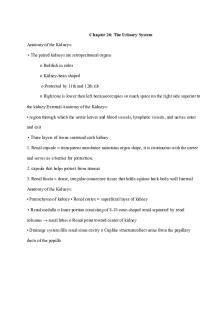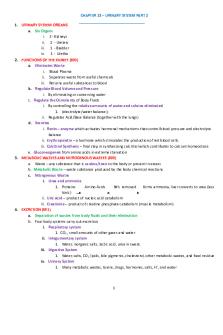Anatomy of the Urinary System PDF

| Title | Anatomy of the Urinary System |
|---|---|
| Course | Structure and Function of Living Organisms |
| Institution | Cardiff University |
| Pages | 3 |
| File Size | 63.9 KB |
| File Type | |
| Total Downloads | 238 |
| Total Views | 783 |
Summary
Anatomy of the Urinary SystemFunctions of the Urinary System Regulation of volume and solute concentration of blood plasma – blood volume, pH Removal of waste products produced by cellular metabolism Elimination of waste products into the environmentBasic Structure Urine production – kidneys ...
Description
Anatomy of the Urinary System Functions of the Urinary System
Regulation of volume and solute concentration of blood plasma – blood volume, pH Removal of waste products produced by cellular metabolism Elimination of waste products into the environment
Basic Structure
Urine production – kidneys Urine transfer to the bladder – ureters transfer the urine to the bladder Urine storage – in bladder Urine release – urethra
Kidneys
Located either side of the midline on the posterior wall of the abdomen Location (T12-L3) The right kidney is located slightly inferior to the left (liver) Behind the peritoneal peritoneum – retroperitoneal Highly vascular Surrounded by a thick layer of fat – perinephric fat (outside capsule) Surrounded by ribs 11 and 12 Renal capsule – collagen rich membrane which supports the tissue of the kidney Renal fascia – collagenous membrane Suspensory fibres connect renal fascia to kidney and limit movement of kidney Start development in the pelvis then rise upwards
Adrenal Glands
Cortex - Corticosteroids, aldosterone - Sodium and water retention BP and volume Medulla - Adrenaline and noradrenaline - ‘Fight or flight’
Structure
150g (largest 1.8kg) : 10cm long, 5cm wide, 2.5cm thick Indented ovoid – bean shaped Hilum – located medially (structures enter and leave) Cortex surrounds pyramids Large blood supply – 20-25% of cardiac output Its internal features can be divided into the outer renal cortex which is in contact with the fibrous renal capsule Renal columns divide the inner renal medulla into 8 – 16 pyramidal shaped structures called the renal pyramids The pyramids and their associated cortex are collectively known as a renal lobe The boundaries of these lobes can be seen during foetal development, and some evidence of these may persist in some even after birth
Renal pyramids collectively form the medulla
Renal Lobe
Contains the functional unit = nephron The renal cortex of a lobe contains the filtration equipment (the cortical nephrons) and their associated collecting ducts While the renal pyramids contain the loops of Henle, where water is reabsorbed from the filtration system, and the majority of the collecting ducts which deliver urine to the tip of the pyramid The tip of each pyramid, known as the renal papilla is the point at which urine is excreted
Renal cortex – proximal and distal parts of the nephron and collecting ducts (medullary rays)
Renal medulla (pyramids) – Loop of Henlé and collecting ducts (collection and delivery of urine)
Minor calyx – collects urine from pyramids
Major calyx – where 2 minor calyxes meet
Urine drains in major calyx the renal pelvis
Urine passes out through the ureter
Ureters
Hollow muscular tubes 25-30cm in length which propel urine from the kidney to the bladder
Located in both the abdomen and pelvis
Retroperitoneal throughout their length
Enter the bladder obliquely
Backflow into the ureters is prevented when the bladder is full; compression closes off the ureters – valves
1 of 125 people have a duplex ureter
Urinary Bladder
Lined superiorly by peritoneum When empty the bladder is roughly tetrahedral in shape Shaped like the bow of a boat when empty 4 surfaces - Superior - Inferolateral x2 - Posterior = base/ fundus Have folds (rugae) that allow for expansion
Internally, the points at which these structures enter or exit the bladder mark the 3 corners of a region of thickened mucosa known as the smooth trigone Named as such because of its smooth triangular appearance The trigone has a different appearance to the rest of the bladder due to its differing developmental origin The trigone is thought to acts as a funnel, which channels urine into the urethra during micturition Made of smooth muscle (detrusor muscle) Usually capacity of around 0.75 litres
Female Urethra
Short 4-5cm Passes through the pelvic floor and opens anterior to the vagina
Male Urethra
20cm in length Prostate S-shaped = 4 regions - Pro-prostatic - Prostatic - Membranous - Penile
Urethral Sphincters
Internal sphincter – junction of the bladder with the urethra (involuntary) External sphincters – inferior to the prostate (voluntary)...
Similar Free PDFs

Anatomy of the Urinary System
- 3 Pages

Anatomy of the Nervous System
- 15 Pages

Chapter 15 The Urinary System
- 6 Pages

Chapter 9 The Urinary System
- 11 Pages

Chapter 26 The Urinary System
- 8 Pages

Urinary System
- 17 Pages

The Urinary System-general notes
- 2 Pages

Urinary system Summary
- 6 Pages

Chapter 26 The Urinary System 7
- 3 Pages

Urinary System Lecture Notes
- 15 Pages

Urinary System Review
- 3 Pages
Popular Institutions
- Tinajero National High School - Annex
- Politeknik Caltex Riau
- Yokohama City University
- SGT University
- University of Al-Qadisiyah
- Divine Word College of Vigan
- Techniek College Rotterdam
- Universidade de Santiago
- Universiti Teknologi MARA Cawangan Johor Kampus Pasir Gudang
- Poltekkes Kemenkes Yogyakarta
- Baguio City National High School
- Colegio san marcos
- preparatoria uno
- Centro de Bachillerato Tecnológico Industrial y de Servicios No. 107
- Dalian Maritime University
- Quang Trung Secondary School
- Colegio Tecnológico en Informática
- Corporación Regional de Educación Superior
- Grupo CEDVA
- Dar Al Uloom University
- Centro de Estudios Preuniversitarios de la Universidad Nacional de Ingeniería
- 上智大学
- Aakash International School, Nuna Majara
- San Felipe Neri Catholic School
- Kang Chiao International School - New Taipei City
- Misamis Occidental National High School
- Institución Educativa Escuela Normal Juan Ladrilleros
- Kolehiyo ng Pantukan
- Batanes State College
- Instituto Continental
- Sekolah Menengah Kejuruan Kesehatan Kaltara (Tarakan)
- Colegio de La Inmaculada Concepcion - Cebu




